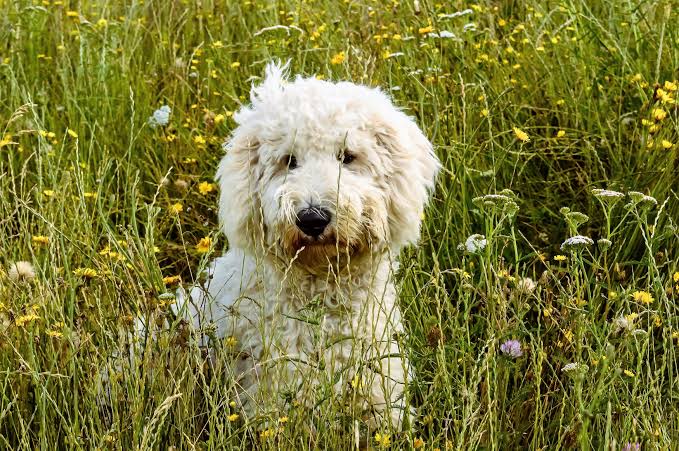
Welcome to the wonderful world of American Labradoodles! If you’re considering adding one of these adorable, fluffy bundles of joy to your family, or simply curious about what makes them so special, you’ve come to the right place.
Let’s dive into the fascinating mix that is the American Labradoodle. Imagine combining the loyal and loving nature of the Labrador Retriever with the intelligence and hypoallergenic coat of the Poodle.
What do you get? A Labradoodle, of course!
Origin and History of American Labradoodles
The story of the Labradoodle begins in the late 1980s in Australia. The breed was developed with a noble purpose: to create a hypoallergenic guide dog. The idea was to combine the gentleness and trainability of the Labrador Retriever with the low-shedding coat of the Poodle.
The goal was a guide dog suitable for people with allergies to dog fur and dander.
The first known intentional crossbreeding of a Labrador Retriever and a Standard Poodle was undertaken by the Royal Guide Dog Association of Australia. This crossbreeding resulted in a litter of puppies that marked the first generation of Labradoodles.
The intention behind this breeding was to produce a dog with a temperament suitable for guide dog work and a coat that was more tolerable for individuals with allergies.
Understanding the Labradoodle Breed

Labradoodles are a crossbreed, blending the genetic lines of the Labrador Retriever and the Poodle. This mix aims to bring together the best traits of both breeds. Labrador Retrievers are known for their friendly nature and trainability, making them popular as family pets and working dogs.
Poodles, on the other hand, are prized for their intelligence, hypoallergenic coats, and elegant stature. The Labradoodle is not a purebred dog but a carefully crafted hybrid.
The genetics of Labradoodles can vary significantly depending on the specific traits breeders are aiming to enhance, such as coat type, size, or temperament. This genetic diversity can influence not only the physical characteristics of Labradoodles but also their health and behavior.
Characteristic Traits and Temperament
Labradoodles typically inherit the best qualities from both parent breeds. They are generally friendly, energetic, and highly trainable. They often exhibit a playful and affectionate nature, making them excellent companions and family pets. These dogs are known for their social temperament, enjoying the company of humans and other dogs alike.
Intelligence is a hallmark of the Labradoodle, inherited from both the Labrador Retriever and the Poodle. This intelligence makes them highly responsive to training, and they often excel in obedience and agility activities. They are also known for their loyalty and eagerness to please, traits that endear them to their owners.
Comparison with Parent Breeds
In comparison to their parent breeds, Labradoodles tend to have a more hypoallergenic coat than Labrador Retrievers, thanks to the Poodle’s influence.
However, it’s important to note that ‘hypoallergenic’ does not mean allergy-free. Labradoodles typically shed less and produce fewer allergens, but this can vary widely among individual dogs.
From the Labrador Retriever, Labradoodles inherit a robust and athletic build, along with a love for physical activity. They often share the Labrador’s affinity for water and retrieving games. From the Poodle side, they inherit the curly coat and the propensity for being less shedding, making them a popular choice for allergy sufferers.
Varieties of American Labradoodles

Labradoodles come in three primary sizes: Miniature, Medium, and Standard. Miniature Labradoodles typically weigh between 15 to 25 pounds and stand around 14 to 16 inches tall at the shoulder.
Medium Labradoodles are slightly larger, generally weighing between 30 to 45 pounds and standing 18 to 20 inches tall. Standard Labradoodles are the largest, weighing anywhere from 50 to 65 pounds and standing 21 to 24 inches tall.
The size of a Labradoodle can affect its suitability for different living environments and lifestyles. Miniature Labradoodles are well-suited for apartment living or homes with smaller yards, while Medium and Standard Labradoodles may need more space and exercise.
Coat Types and Colors
Labradoodle coats can vary significantly in texture and color. The three primary coat types are wool, fleece, and hair. Wool coats are similar to that of a Poodle, with tight curls and a soft texture.
Fleece coats are wavy and silky, often considered the most hypoallergenic. Hair coats are straighter and more similar to that of a Labrador Retriever.
The color of Labradoodle coats can range widely, including black, white, cream, gold, red, chocolate, and even multi-colored or partial patterns. The variety in coat types and colors is one of the breed’s appealing aspects, offering a wide range of aesthetics for potential owners.
Health and Lifespan of Labradoodles

Labradoodles are generally healthy dogs, but like all breeds, they are prone to certain health issues. Their lifespan typically ranges from 12 to 15 years, which can be influenced by various factors including genetics, lifestyle, and care.
Common health issues include:
- Hip and Elbow Dysplasia: This is a common condition in larger dogs, including Labradoodles, where the hip or elbow joint doesn’t fit together perfectly, leading to arthritis or lameness.
- Ear Infections: Due to their floppy ears, Labradoodles are prone to ear infections. Regular cleaning and monitoring are essential.
- Eye Diseases: Conditions like Progressive Retinal Atrophy and cataracts can occur in this breed, potentially leading to vision loss.
- Allergies: Labradoodles can suffer from various allergies, ranging from food allergies to environmental allergies.
- Addison’s Disease: This is a hormonal disorder where the dog’s body doesn’t produce enough adrenal hormones.
Lifespan and Factors Affecting Longevity
The lifespan of a Labradoodle can be influenced by factors like diet, exercise, and overall health care. Providing a balanced diet, regular exercise, and routine health checks can significantly improve their lifespan.
Importance of Genetic Testing and Responsible Breeding
Genetic testing is crucial in identifying potential health risks in Labradoodles. Reputable breeders often conduct genetic tests to ensure they are not passing on hereditary conditions. Responsible breeding practices, including health screenings for breeding dogs, can help reduce the incidence of genetic diseases.
Grooming and Care of Labradoodles
- Coat Care: Labradoodles require regular grooming to prevent matting, especially those with wool or fleece coats. Brushing a few times a week and professional grooming every 6-8 weeks is recommended.
- Nail Trimming: Regular nail trimming is important to prevent discomfort and mobility issues.
- Dental Hygiene: Regular teeth brushing and dental checks are crucial for preventing dental diseases.
Exercise Needs and Activity Levels
Labradoodles are active dogs that require regular exercise to maintain their physical and mental health. Daily walks, play sessions, and mental stimulation activities are essential. Their activity level can vary based on their size, with larger Labradoodles generally requiring more exercise.
Diet and Nutrition
A balanced diet tailored to their age, size, and activity level is crucial for Labradoodles. High-quality dog food that meets their nutritional requirements is important. It’s also vital to monitor their food intake to prevent obesity, which can lead to health issues.
Training and Socialization
Labradoodles, inheriting intelligence from both Labrador Retrievers and Poodles, respond well to training. Basic obedience training, including commands like ‘sit’, ‘stay’, ‘come’, and ‘heel’, is essential. Consistency and positive reinforcement techniques work best for this breed. House training should start early, using a routine and rewards to establish good habits.
Early socialization is crucial for Labradoodles. Exposure to different people, pets, environments, and experiences during their puppyhood helps in developing a well-adjusted, confident adult dog. This reduces the likelihood of fearfulness or aggression in unfamiliar situations.
Dealing with Common Behavioral Issues
Labradoodles can exhibit common behavioral issues like chewing, jumping, or barking if not properly trained and exercised. Addressing these issues requires consistent training and ample mental and physical stimulation.
These dogs are adaptable and can thrive in various living environments, from apartments to large homes with yards. However, they do require adequate space for daily exercise and mental stimulation.
If you notice your dog developing adverse behavioural traits or not obeying your commands, you can also hire a professional to train your dog.
Finding the Right Labradoodle
- Choosing a Reputable Breeder: When selecting a Labradoodle, it’s important to choose a reputable breeder who prioritizes the health and temperament of their puppies. Look for breeders who perform health screenings, offer genetic testing results, and provide a good environment for their dogs.
- Considering Adoption from Rescue Organizations: Adoption from rescue organizations is another option. Many Labradoodles end up in rescues and need loving homes. Adopting can be a rewarding way to find a companion while providing a dog with a second chance.
- Assessing the Right Labradoodle for Your Lifestyle: Consider your lifestyle and environment when choosing a Labradoodle. Factors like size, coat type, and energy level should match your living situation and ability to provide care and exercise.
Conclusion
In summary, the American Labradoodle is a remarkable breed, combining intelligence, affection, and adaptability. Understanding their training, socialization, and care requirements is essential for a harmonious relationship.
Their suitability for families, ability to adapt to different environments, and overall charming demeanor make them a popular choice.
As we look to the future, the American Labradoodle stands as a testament to the success of thoughtful crossbreeding and responsible pet ownership. Happy petting!

